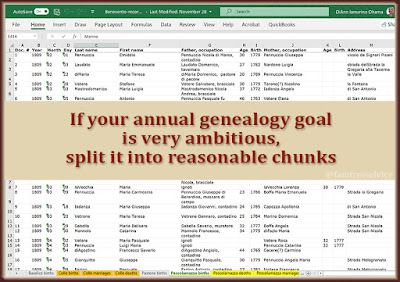Get ready to set genealogy goals that will make the most of your time.
It's just around the corner. Time to get serious about writing your 2020 Genealogy Goals. Over the past 2 years I've realized the secrets to being successful with your goals.
Forget those silly New Year's resolutions. You're going to craft the ideal genealogy goals list. Simply follow these 3 rules.
#1 Set Yourself Up for Success
Your goals need to be achievable. Instead of setting yourself up for failure, make sure it's possible to reach your goal within the year.
If your goal is to find and visit your cousins in the country where your ancestors were born, you may not be able to do that this year. Start smaller. Find out all you can about the relatives who stayed in the old country.
When I visited the cemetery in Italy where 2 of my great grandparents were born, I saw Vincenzo Sarracino's grave. Based on his name and age—and his photo on the grave—I thought he might be my grandmother's first cousin.
It was 3 years later that I learned I was right! I found and contacted Sarracino cousins several hours away from me in Pittsburgh. Luckily, my husband had a wedding to attend in Pittsburgh. So we visited my new relatives.
My family showed me lots of photos. I recognized Vincenzo Sarracino! These cousins gave me the background on the man I'd discovered in the cemetery 3 years earlier.
That goes to show you some goals take longer than a year. It's out of your control. Finding and visiting distant cousins is a wonderful goal. But it's not suitable for your 2020 list of genealogy goals. Try for something that's in your power.
 |
| If this were an annual goal, I'd have failed twice. Do what's in your power. |
#2 Be Specific and Limited
If your goal is too vague, how will you work toward it? What steps will you take?
For example, if your goal is "Build my husband's family tree," how will you know when you're done? A family tree is never done! Maybe all you want to do is create a couple of generations' worth of his family tree for starters. You can take a broad goal like that and break it down into its parts:
- Find his parents' marriage record.
- Search for his parents and their families in every census year.
- Search for his grandparents' immigration records.
Think of a bigger, somewhat vague goal as a series of steps. Choose 1 or 2 of the steps and make them your goals.
 |
| Success keeps you going! Split that big genealogy project into manageable parts. |
#3 Break Big Tasks into Modules
I have some lofty genealogy goals. I'd need to work on them full-time for a long time to get them done. But if you divide a big task into modules, chunks, or units, you can make measurable progress.
Here are my 2 really, really big projects and how I'm handling them.
Project A. Enter key facts from my collection of Italian vital records in a spreadsheet. The result will be a database that's easy to search and to share.
When I started entering facts from each vital record into a spreadsheet, it was wonderful. Those facts were now searchable. If I was looking for the birth of a Giovanni Pozzuto whose father was Giuseppe, I could search for that. But it takes a long time to create. I found ways to go faster, but it's still a huge task.
So, as a 2019 genealogy goal, I committed to a smaller goal: Log the first 5 years' worth of birth records from each of my towns into the spreadsheet.
I finished that by March! Having all those vital records in a searchable format is fabulous for my research. I want to get more ambitious this year. I'll go for 5 years of death records and 5 years of marriage records from each town.
And if I finish that early, I can tack on another 5 years of births. The key is to use small chunks you know you can finish.
 |
| Don't burden yourself with a huge task. Achieve your goal in steps. |
Project B. Rename every document image in my collection of Italian vital records.
It dawned on me that I could have a searchable database even before I finish Project A. If I rename the image of a death record to include the deceased's name, that person is now searchable on my computer.
I started by renaming the marriage records for my grandfather's town of Colle Sannita. The file names get really long when an image shows 2 pages, 2 brides, 2 grooms. But they're searchable!
I was so happy with the results—and how fast it seemed to go—that I pushed further. I renamed the entire town's files. And I'm moving on to other towns. I have one little hamlet with a very limited number of vital records. I renamed them all within 90 minutes. Then I moved on to another town.
Getting more files renamed is going to be a top goal for me in 2020. I'll break it into chunks, like all birth records for one town. When that's done I'll move on to all births for another town. Every bit of that effort will pay off.
Make yourself and your family tree happy this coming year. Set a small number of 2020 Genealogy Goals you know you can get done.
And speaking of genealogy goal-setting:










